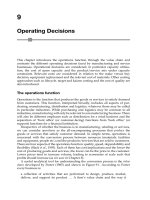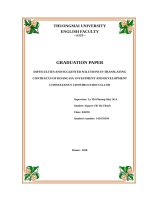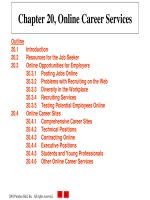Lecture E-commerce and e-business for managers - Chapter 5: Internet hardware, software and communications
Bạn đang xem bản rút gọn của tài liệu. Xem và tải ngay bản đầy đủ của tài liệu tại đây (587.98 KB, 39 trang )
Chapter 5, Internet Hardware,
Software and Communications
Outline
5.1
Introduction
5.2
Structure of the Internet
5.3
Hardware
5.3.1
Servers
5.3.2
Communications Media
5.3.3
Storage Area Networks (SANs)
5.4
Connecting to the Internet
5.4.1 Digital Subscriber Lines (DSL)
5.4.2 Broadband
5.4.3 Integrated Services Digital Network (ISDN)
5.4.4 T1 and T3 Lines
5.5
Internet2
5.6
Software
5.6.1 Application Service Providers (ASPs)
5.6.2
Databases
2001 Prentice Hall, Inc. All rights reserved.
Chapter 5, Internet Hardware,
Software and Communications
Outline
5.7
Operating Systems
5.7.1
UNIX
5.7.2
Microsoft Windows
5.7.3
Linux
5.7.4
Mac OS X
5.8
Enhancing Business Communication
5.8.1
Intranets and Extranets
5.8.2
Streaming Audio and Video
5.8.3
Internet Telephony
5.8.4
Web Casting and Webconferencing
2001 Prentice Hall, Inc. All rights reserved.
5.1 Introduction
•
•
•
•
•
Connection media
Cost of connecting
Streaming media (audio and video)
Internet telephony
Technologies used to enhance online business
communications
2001 Prentice Hall, Inc. All rights reserved.
5.2 Structure of the Internet
• IP address (Internet Protocol)
– Computers use IP addresses to locate other computers on the
Internet
• Packet
– Source address, a destination address, sequencing
information, errorcontrol information and the data to be
delivered to the destination address
• Router
– Used to move packets across the Internet efficiently
2001 Prentice Hall, Inc. All rights reserved.
5.3 Hardware
• The Internet employs many advanced hardware
technologies
– Various communications media used to connect hosts
– The roles hosts play on the Internet
• Servers
• Communications Media
• Storage Area Networks (SAN)
2001 Prentice Hall, Inc. All rights reserved.
5.3.1 Servers
• Server
– A host on the Internet that manages network resources and
fulfills requests from clients
– Web servers, email servers, database servers and file servers
– A single server may provide multiple services
• A Web server stores Web pages and delivers the
pages to clients upon request
• Protocols for delivering information over the Web
–
–
–
–
Hypertext transfer protocol (HTTP)
File transfer protocol (FTP)
Post office protocol (POP)
Simple mail transfer protocol (SMTP)
2001 Prentice Hall, Inc. All rights reserved.
5.3.2 Communications Media
• Communications medium
– The hardware that connects computers and other digital
equipment
• Bandwidth
– Indicates how much data can be transferred through the
medium in a fixed amount of time
– Usually measured in bits per second (bps)
• Copper wire
– The primary communications medium
2001 Prentice Hall, Inc. All rights reserved.
5.3.2 Communications Media
• Fiberoptic cable
– Composed of flexible glass fiber, is thinner and lighter than
traditional copper wire, yet has much wider bandwidth
– Uses short bursts of light to represent bits
• Optical modem
– Modem stands for modulator and demodulator
– Translates digital signals from computers into light through a
process called modulation
• Opto chip
– Converts the most basic particle of light, the photon, into an
electric current
– Allows tremendous amounts of data to be sent over fiber
optic networks through particles 100 times smaller than the
diameter of a human hair
2001 Prentice Hall, Inc. All rights reserved.
5.3.2 Communications Media
• The strength of a signal transmitted over a
communications medium is reduced as the signal
travels farther and farther
• Repeater
– Can be used to alleviate this problem by amplifying and
retransmitting the signal across segments of copper wire or
fiberoptic cable
• Transmission costs
– Fiberoptic cable is more expensive than copper wire
– Installation of fiberoptic cable is more complicated than
installation of copper wire
– Fiberoptic cable requires fewer repeaters
2001 Prentice Hall, Inc. All rights reserved.
5.3.3 Storage Area Networks
• Companies produce large volumes of data to
support sales analysis tools, enterprise resource
planning (ERP) systems, multimedia Web sites
and ecommerce systems
• Storage Area Network (SAN)
– Provides highcapacity, reliable data storage and delivery on
a network
– Allows network administrators to collect data in logical
groups on data servers distributed throughout the network
– SAN devices store large volumes of data and may also
provide backup and recovery services
2001 Prentice Hall, Inc. All rights reserved.
5.3.3 Storage Area Networks
• Mirroring technology
– A SAN device stores redundant copies of data, so that if one
copy is lost or damaged, a mirrored copy can be used
• Fiberchannel technology
– A highspeed communications medium based on fiberoptic
technology that provides transfer rates of 100 Mbps
• Network storage devices providers
– EMC
– Compaq
– StorageNetworks
2001 Prentice Hall, Inc. All rights reserved.
5.4 Connecting to the Internet
• Most home users subscribe to an Internet Service
Provider (ISP) to connect to the Internet
– Some charge fixed monthly fees for Internet access
– Some offer free Internet access in return for personal
demographic data
• Analog modem
– User connects to an ISP using the modem, which then
connects the user to the Internet
– Takes digital signals from the computer and turns them into
analog signals
• Analog signals can be transmitted over a telephone line just
like a human voice
– A modem at the ISP then converts the sound back into a
digital signal that can be transmitted over the Internet
2001 Prentice Hall, Inc. All rights reserved.
5.4 Connecting to the Internet
• Free Internet access providers
– NetZero
– IsFree.com
– ACI
– Address.com
• Web TV
– A low-cost technology for connecting to the Internet through
the user’s television, instead of a PC
– WebTV users can dial into an ISP through a modem to surf
the Web, send and receive e-mail and chat with other people
– The basic WebTV system includes a wireless keyboard, an
8.6-GB, a hard drive and a 56-Kbps modem
2001 Prentice Hall, Inc. All rights reserved.
5.4.1 Digital Subscriber Lines
• Digital Subscriber Lines (DSL)
– Offers highbandwidth Internet access over existing copper
telephone lines
– Splits your phone line into three informationcarrying
channels
– DSL connections require special hardware at the local
telephone company’s central office and at the user’s location
2001 Prentice Hall, Inc. All rights reserved.
5.4.1 Digital Subscriber Lines
• IAD (integrated access device)
– Provides network connections for highspeed Internet
access, as well as connections for multiple voice telephone
lines
• ADSL (asymmetric DSL)
– the connection speed for sending data to the Internet
(upstream) is slower than the connection speed for receiving
data from the Internet (downstream)
• VoDSL (voice over DSL)
– Provides voice telephone services and highspeed data
access over a single standard telephone line
• SDSL (symmetric DSL)
– Transfers data at the same speed both upstream and
downstream
2001 Prentice Hall, Inc. All rights reserved.
5.4.1 Digital Subscriber Lines
Metho d
Ava ila b ility fo r
Businesses
Modem
Sp eed (Kb p s) Send Sp eed = Co st
Rec eive
Sp eed
33–56
No
Very low
Cable modem
ISDN
xDSL
64–1500
56–128
384–55,000
Very limited
Widely available
Limited
No
Yes
No
Medium
High
Low
Universal
Frame relay/T1
64–1544
Yes
Very high
Widely available
Fig. 5.1 Internet c o nnec tio n c o m p a riso n c ha rt. (Co urtesy o f GLINK, LLC.)
2001 Prentice Hall, Inc. All rights reserved.
5.4.2 Broadband
• Broadband
– A category of highbandwidth Internet service provided
mainly by cable television and telephone companies to home
users
– Can handle voice, data and video information
– Enables videoconferencing, realtime voice and streaming
media applications
– Always connected, eliminating the need to dial into an ISP
• Cable modem
– Translates digital signals for transmission over the same
cables that bring cable television to homes and businesses
– Connections is shared among many users
2001 Prentice Hall, Inc. All rights reserved.
5.4.3 Integrated Services Digital
Network (ISDN)
• ISDN (Integrated Services Digital Network)
– Provides highspeed connections to the Internet over both
digital and standard telephone lines
– Limited service
– Costly connection
– Divided into three channels that each perform different tasks
• Two bearer channels each support data transfers, while the
data channel is used to transmit routing information
– ISDNZone
2001 Prentice Hall, Inc. All rights reserved.
5.4.4 T1 and T3 Lines
• T1 line
– A dedicated connection that supports data rates of 1.544 Mb
per second
– Made up of 24 channels
• T3 line
– Supports data rates of 43Mbps and is made up of 672
channels that each support 64Kbps
• T1 and T3 lines can be used for both voice and
data communication
• Everythingt1.com
2001 Prentice Hall, Inc. All rights reserved.
5.5 Internet2
• Consortium developing next generation of the
Internet
– Abeline
• A highspeed network currently used by Internet2 consortium
members, will soon be able to transfer 2.4 gigabits of data per
second
– Teleimmersion
• Allows users in different locations to share information in real
time—even 3D images
– Virtual laboratory
• Enable researchers worldwide to collaborate on projects
– Digital libraries
• Storage of audio and video files, enabling a search for a
movie by a line from its soundtrack.
2001 Prentice Hall, Inc. All rights reserved.
5.6 Software
• Application Service Providers
• Databases
2001 Prentice Hall, Inc. All rights reserved.
5.6.1 Application Service Provider
• Provide customized business software applications
over the Internet
• Maintains and updates the application as necessary
• Companies can eliminate the costs associated with
developing and maintaining business applications
• Virtual private networks (VPNs)
– Allow customers to connect to their applications securely
over the Internet
– VPNs use the pointtopoint tunneling protocol (PPTP) to
create a secure channel of communication between the
customer and the ASP
2001 Prentice Hall, Inc. All rights reserved.
5.6.2 Databases
• Database
– An integrated collection of data
• Database management system (DBMS)
– Provides mechanisms for storing and organizing data in a
manner that facilitates satisfying sophisticated queries and
data manipulations
• Structured Query Language (SQL
– Almost universally used with relational database systems to
make queries (i.e., to request information that satisfies given
criteria) and manipulate data
2001 Prentice Hall, Inc. All rights reserved.
5.6.2 Databases
• Relational database model
– A logical representation of the data that allows the
relationships between the data to be considered
independently of the physical implementation of the data
structures
• Popular enterprise-level relational database
systems:
–
–
–
–
–
Microsoft Sequel Server
Oracle
Sybase
DB2
Informix
2001 Prentice Hall, Inc. All rights reserved.
5.7 Operating Systems
• Operating system (OS)
– Software that manages the resources on a computer
– Multiuser OS
• Allows more than one user to run programs simultaneously
– Multiprocessor OS
• Controls a computer that has many hardware CPUs
– Multitasking OS
• Allows multiple applications to run simultaneously
– Multithreading OS
• Allows an individual program to specify that several activities
should be performed in parallel
• Major operating systems used in desktop
computers are UNIX , Linux , Macintosh and
Windows
2001 Prentice Hall, Inc. All rights reserved.









